
Carbamazepine
概要
説明
カルバマゼピンは、てんかんや神経障害性疼痛の治療に主に用いられる、よく知られた抗けいれん薬および鎮痛薬です。また、双極性障害の二次治療薬として、および統合失調症の補助治療薬としても使用されます。 スイスの化学者、ウォルター・シンドラーが1953年に発見したカルバマゼピンは、1962年に初めて市販され、それ以来、さまざまな神経疾患の治療において不可欠な薬物となっています .
作用機序
カルバマゼピンは、主にナトリウムチャネルの活動を阻害することで効果を発揮します。この作用により、多シナプス神経反応が減少して、後テトニック増強が抑制され、過剰興奮した神経膜が安定化します。 この化合物は、神経伝達物質の放出にも影響を与え、シナプス伝達を調節します .
類似の化合物との比較
カルバマゼピンは、オクスカルバゼピンやエスリカルバゼピン酢酸塩などの他の抗けいれん薬と比較されることがよくあります。3つの化合物はすべて、電圧依存性ナトリウムチャネルを阻害するという同様の作用機序を共有していますが、薬物動態プロファイルとナトリウムチャネルの不活性状態に対する選択性に違いがあります。 オクスカルバゼピンとエスリカルバゼピン酢酸塩は、安全性が向上し、副作用が少ない、新しい誘導体です .
類似の化合物
- オクスカルバゼピン
- エスリカルバゼピン酢酸塩
- フェニトイン
- バルプロ酸
カルバマゼピンは、確立された有効性と広範な研究の歴史により、神経疾患の治療における独自で貴重な化合物であり続けています。
生化学分析
Biochemical Properties
Carbamazepine works by stabilizing the electrical activity in the brain and nerves . It stops electrical signals from building up in the nerve cells in the brain and also reduces the release of a chemical (neurotransmitter) called glutamate . It is structurally similar to tricyclic antidepressants such as imipramine .
Cellular Effects
This compound has a significant impact on various types of cells and cellular processes. It influences cell function by stabilizing the electric signals in your nerves . This stops the pain signals being sent to your brain . It also has effects on serotonin systems but the relevance to its antiseizure effects is uncertain .
Molecular Mechanism
This compound is a sodium channel blocker . It binds preferentially to voltage-gated sodium channels in their inactive conformation, which prevents repetitive and sustained firing of an action potential . It also acts at adenosine receptors and as an anti-cholinergic .
Temporal Effects in Laboratory Settings
On chronic administration, this compound induces its own metabolism sometimes leading to requirement for increasing the dose after the first month of therapy to maintain effect . This compound metabolism is induced by phenobarbital and phenytoin but inhibited by valproate and lamotrigine .
Dosage Effects in Animal Models
In animal models, this compound at certain doses has shown to reduce immobility in the behavioral despair model . It neither modified the methamphetamine anorectic effect, nor induced anorexia when administered alone .
Metabolic Pathways
This compound is extensively metabolized in the liver, primarily by CYP3A4, to this compound-10,11-epoxide which is pharmacologically active . Additional isoenzymes that contribute to the metabolism of this compound include CYP2C8, CYP2B6, CYP2E1, CYP1A2, and CYP2A6 .
Transport and Distribution
This compound is rapidly absorbed with a bioavailability of 75–85% . Its volume of distribution is 0.8–2.0 L/kg, and plasma protein binding is 75% . The protein binding of the pharmacologically active metabolite, this compound-10,11-epoxide, is 50% .
準備方法
合成ルートと反応条件
カルバマゼピンは、イミノスチルベンをプロトン化媒体中で尿素と反応させることにより合成されます。このプロセスでは、中間体が形成され、その後カルバマゼピンに変換されます。 反応条件には通常、変換を促進するために有機溶媒と酸性剤の使用が含まれます .
工業生産方法
工業的には、カルバマゼピンは連続合成プロセスによって製造されます。この方法は、反応条件を監視および最適化するために、検証済みのインラインラマン分光法と反応速度論的モデリングを採用しています。 連続撹拌槽反応器(CSTR)は、動的平衡を維持し、製品品質の一貫性を確保するために使用されます .
化学反応の分析
反応の種類
カルバマゼピンは、次のようなさまざまな化学反応を起こします。
酸化: カルバマゼピンは酸化されて、活性代謝物であるカルバマゼピン-10,11-エポキシドを生成できます。
還元: 還元反応により、カルバマゼピン-10,11-エポキシドをカルバマゼピンに戻すことができます。
一般的な試薬と条件
酸化: 一般的な酸化剤には、過硫酸一水素カリウムやその他の過酸化物が含まれます。
還元: 水素化ホウ素ナトリウムなどの還元剤を使用できます。
主な生成物
酸化: カルバマゼピン-10,11-エポキシド
還元: カルバマゼピン
科学研究への応用
カルバマゼピンは、さまざまな科学研究に広く応用されています。
化学: 薬物代謝および反応機構の研究におけるモデル化合物として使用されます。
生物学: 神経活動および神経伝達物質放出への影響について調査されています。
医学: てんかん、神経障害性疼痛、双極性障害における治療効果について広く研究されています。
科学的研究の応用
Carbamazepine has a wide range of scientific research applications:
Chemistry: Used as a model compound in studies of drug metabolism and reaction mechanisms.
Biology: Investigated for its effects on neuronal activity and neurotransmitter release.
Medicine: Extensively studied for its therapeutic effects in epilepsy, neuropathic pain, and bipolar disorder.
Industry: Employed in the development of new pharmaceutical formulations and drug delivery systems .
類似化合物との比較
Carbamazepine is often compared with other anticonvulsant drugs such as oxcarbazepine and eslicarbazepine acetate. While all three compounds share a similar mechanism of action, inhibiting voltage-gated sodium channels, they differ in their pharmacokinetic profiles and selectivity for the inactivated state of the sodium channel. Oxcarbazepine and eslicarbazepine acetate are newer derivatives with improved safety profiles and fewer side effects .
Similar Compounds
This compound remains a unique and valuable compound in the treatment of neurological disorders due to its well-established efficacy and extensive research history.
特性
IUPAC Name |
benzo[b][1]benzazepine-11-carboxamide | |
|---|---|---|
| Source | PubChem | |
| URL | https://pubchem.ncbi.nlm.nih.gov | |
| Description | Data deposited in or computed by PubChem | |
InChI |
InChI=1S/C15H12N2O/c16-15(18)17-13-7-3-1-5-11(13)9-10-12-6-2-4-8-14(12)17/h1-10H,(H2,16,18) | |
| Source | PubChem | |
| URL | https://pubchem.ncbi.nlm.nih.gov | |
| Description | Data deposited in or computed by PubChem | |
InChI Key |
FFGPTBGBLSHEPO-UHFFFAOYSA-N | |
| Source | PubChem | |
| URL | https://pubchem.ncbi.nlm.nih.gov | |
| Description | Data deposited in or computed by PubChem | |
Canonical SMILES |
C1=CC=C2C(=C1)C=CC3=CC=CC=C3N2C(=O)N | |
| Source | PubChem | |
| URL | https://pubchem.ncbi.nlm.nih.gov | |
| Description | Data deposited in or computed by PubChem | |
Molecular Formula |
C15H12N2O | |
| Record name | carbamazepine | |
| Source | Wikipedia | |
| URL | https://en.wikipedia.org/wiki/Carbamazepine | |
| Description | Chemical information link to Wikipedia. | |
| Source | PubChem | |
| URL | https://pubchem.ncbi.nlm.nih.gov | |
| Description | Data deposited in or computed by PubChem | |
Related CAS |
85756-57-6 (di-hydrate) | |
| Record name | Carbamazepine [USAN:USP:INN:BAN:JAN] | |
| Source | ChemIDplus | |
| URL | https://pubchem.ncbi.nlm.nih.gov/substance/?source=chemidplus&sourceid=0000298464 | |
| Description | ChemIDplus is a free, web search system that provides access to the structure and nomenclature authority files used for the identification of chemical substances cited in National Library of Medicine (NLM) databases, including the TOXNET system. | |
DSSTOX Substance ID |
DTXSID4022731 | |
| Record name | Carbamazepine | |
| Source | EPA DSSTox | |
| URL | https://comptox.epa.gov/dashboard/DTXSID4022731 | |
| Description | DSSTox provides a high quality public chemistry resource for supporting improved predictive toxicology. | |
Molecular Weight |
236.27 g/mol | |
| Source | PubChem | |
| URL | https://pubchem.ncbi.nlm.nih.gov | |
| Description | Data deposited in or computed by PubChem | |
Physical Description |
Solid | |
| Record name | Carbamazepine | |
| Source | Human Metabolome Database (HMDB) | |
| URL | http://www.hmdb.ca/metabolites/HMDB0014704 | |
| Description | The Human Metabolome Database (HMDB) is a freely available electronic database containing detailed information about small molecule metabolites found in the human body. | |
| Explanation | HMDB is offered to the public as a freely available resource. Use and re-distribution of the data, in whole or in part, for commercial purposes requires explicit permission of the authors and explicit acknowledgment of the source material (HMDB) and the original publication (see the HMDB citing page). We ask that users who download significant portions of the database cite the HMDB paper in any resulting publications. | |
Boiling Point |
399.6±45.0 | |
| Record name | Carbamazepine | |
| Source | DrugBank | |
| URL | https://www.drugbank.ca/drugs/DB00564 | |
| Description | The DrugBank database is a unique bioinformatics and cheminformatics resource that combines detailed drug (i.e. chemical, pharmacological and pharmaceutical) data with comprehensive drug target (i.e. sequence, structure, and pathway) information. | |
| Explanation | Creative Common's Attribution-NonCommercial 4.0 International License (http://creativecommons.org/licenses/by-nc/4.0/legalcode) | |
Solubility |
>35.4 [ug/mL] (The mean of the results at pH 7.4), Sol in alcohol, acetone, propylene glycol; practically insol in water, Soluble in chloroform, dimethylformamide, ethylene glycol monomethyl ether, or methanol; only slightly soluble in ethanol or glacial acetic acid, 1.52e-01 g/L | |
| Record name | SID855967 | |
| Source | Burnham Center for Chemical Genomics | |
| URL | https://pubchem.ncbi.nlm.nih.gov/bioassay/1996#section=Data-Table | |
| Description | Aqueous solubility in buffer at pH 7.4 | |
| Record name | CARBAMAZEPINE | |
| Source | Hazardous Substances Data Bank (HSDB) | |
| URL | https://pubchem.ncbi.nlm.nih.gov/source/hsdb/3019 | |
| Description | The Hazardous Substances Data Bank (HSDB) is a toxicology database that focuses on the toxicology of potentially hazardous chemicals. It provides information on human exposure, industrial hygiene, emergency handling procedures, environmental fate, regulatory requirements, nanomaterials, and related areas. The information in HSDB has been assessed by a Scientific Review Panel. | |
| Record name | Carbamazepine | |
| Source | Human Metabolome Database (HMDB) | |
| URL | http://www.hmdb.ca/metabolites/HMDB0014704 | |
| Description | The Human Metabolome Database (HMDB) is a freely available electronic database containing detailed information about small molecule metabolites found in the human body. | |
| Explanation | HMDB is offered to the public as a freely available resource. Use and re-distribution of the data, in whole or in part, for commercial purposes requires explicit permission of the authors and explicit acknowledgment of the source material (HMDB) and the original publication (see the HMDB citing page). We ask that users who download significant portions of the database cite the HMDB paper in any resulting publications. | |
Mechanism of Action |
Carbamazepine's mechanism of action is not fully elucidated and is widely debated. One major hypothesis is that carbamazepine inhibits sodium channel firing, treating seizure activity. Animal research studies have demonstrated that carbamazepine exerts its effects by lowering polysynaptic nerve response and inhibiting post-tetanic potentiation. In both cats and rats, carbamazepine was shown to decrease pain caused by infraorbital nerve stimulation. A decrease in the action potential in the nucleus ventralis of the thalamus in the brain and inhibition of the lingual mandibular reflex were observed in other studies after carbamazepine use. Carbamazepine causes the above effects by binding to voltage-dependent sodium channels and preventing action potentials, which normally lead to stimulatory effects on nerves. In bipolar disorder, carbamazepine is thought to increase dopamine turnover and increase GABA transmission, treating manic and depressive symptoms. A common issue that has arisen is resistance to this drug in up to 30% of epileptic patients, which may occur to altered metabolism in patients with variant genotypes. A potential therapeutic target to combat carbamazepine resistance has recently been identified as the EPHX1 gene promoter, potentially conferring resistance to carbamazepine through methylation., Anticonvulsant: Exact mechanism unknown; may act postsynaptically by limiting the ability of neurons to sustain high frequency repetitive firing of action potentials through enhancement of sodium channel inactivation; in addition to altering neuronal excitability, may act presynaptically to block the release of neurotransmitter by blocking presynaptic sodium channels and the firing of action potentials, which in turn decreases synaptic transmission., Antineuralgic: Exact mechanism unknown; may involve gamma-aminobutyric acid (GABAB) receptors, which may be linked to calcium channels., Antimanic; antipsychotic: Exact mechanism is unknown; may be related to either the anticonvulsant or the antineuralgic effects of carbamazepine, or to tis effects on neurotransmitter modulator systems., Antidiuretic: Exact mechanism unknown; may exert a hypothalamic effect on the osmoreceptors mediated via secretion of antidiuretic hormone (ADH), or may have a direct effect on the renal tubule., For more Mechanism of Action (Complete) data for CARBAMAZEPINE (8 total), please visit the HSDB record page. | |
| Record name | Carbamazepine | |
| Source | DrugBank | |
| URL | https://www.drugbank.ca/drugs/DB00564 | |
| Description | The DrugBank database is a unique bioinformatics and cheminformatics resource that combines detailed drug (i.e. chemical, pharmacological and pharmaceutical) data with comprehensive drug target (i.e. sequence, structure, and pathway) information. | |
| Explanation | Creative Common's Attribution-NonCommercial 4.0 International License (http://creativecommons.org/licenses/by-nc/4.0/legalcode) | |
| Record name | CARBAMAZEPINE | |
| Source | Hazardous Substances Data Bank (HSDB) | |
| URL | https://pubchem.ncbi.nlm.nih.gov/source/hsdb/3019 | |
| Description | The Hazardous Substances Data Bank (HSDB) is a toxicology database that focuses on the toxicology of potentially hazardous chemicals. It provides information on human exposure, industrial hygiene, emergency handling procedures, environmental fate, regulatory requirements, nanomaterials, and related areas. The information in HSDB has been assessed by a Scientific Review Panel. | |
Color/Form |
Crystals from absolute ethanol and benzene, White to off-white powder | |
CAS No. |
298-46-4 | |
| Record name | Carbamazepine | |
| Source | CAS Common Chemistry | |
| URL | https://commonchemistry.cas.org/detail?cas_rn=298-46-4 | |
| Description | CAS Common Chemistry is an open community resource for accessing chemical information. Nearly 500,000 chemical substances from CAS REGISTRY cover areas of community interest, including common and frequently regulated chemicals, and those relevant to high school and undergraduate chemistry classes. This chemical information, curated by our expert scientists, is provided in alignment with our mission as a division of the American Chemical Society. | |
| Explanation | The data from CAS Common Chemistry is provided under a CC-BY-NC 4.0 license, unless otherwise stated. | |
| Record name | Carbamazepine [USAN:USP:INN:BAN:JAN] | |
| Source | ChemIDplus | |
| URL | https://pubchem.ncbi.nlm.nih.gov/substance/?source=chemidplus&sourceid=0000298464 | |
| Description | ChemIDplus is a free, web search system that provides access to the structure and nomenclature authority files used for the identification of chemical substances cited in National Library of Medicine (NLM) databases, including the TOXNET system. | |
| Record name | Carbamazepine | |
| Source | DrugBank | |
| URL | https://www.drugbank.ca/drugs/DB00564 | |
| Description | The DrugBank database is a unique bioinformatics and cheminformatics resource that combines detailed drug (i.e. chemical, pharmacological and pharmaceutical) data with comprehensive drug target (i.e. sequence, structure, and pathway) information. | |
| Explanation | Creative Common's Attribution-NonCommercial 4.0 International License (http://creativecommons.org/licenses/by-nc/4.0/legalcode) | |
| Record name | carbamazepine | |
| Source | DTP/NCI | |
| URL | https://dtp.cancer.gov/dtpstandard/servlet/dwindex?searchtype=NSC&outputformat=html&searchlist=755920 | |
| Description | The NCI Development Therapeutics Program (DTP) provides services and resources to the academic and private-sector research communities worldwide to facilitate the discovery and development of new cancer therapeutic agents. | |
| Explanation | Unless otherwise indicated, all text within NCI products is free of copyright and may be reused without our permission. Credit the National Cancer Institute as the source. | |
| Record name | carbamazepine | |
| Source | DTP/NCI | |
| URL | https://dtp.cancer.gov/dtpstandard/servlet/dwindex?searchtype=NSC&outputformat=html&searchlist=169864 | |
| Description | The NCI Development Therapeutics Program (DTP) provides services and resources to the academic and private-sector research communities worldwide to facilitate the discovery and development of new cancer therapeutic agents. | |
| Explanation | Unless otherwise indicated, all text within NCI products is free of copyright and may be reused without our permission. Credit the National Cancer Institute as the source. | |
| Record name | Carbamazepine | |
| Source | EPA DSSTox | |
| URL | https://comptox.epa.gov/dashboard/DTXSID4022731 | |
| Description | DSSTox provides a high quality public chemistry resource for supporting improved predictive toxicology. | |
| Record name | Carbamazepine | |
| Source | European Chemicals Agency (ECHA) | |
| URL | https://echa.europa.eu/substance-information/-/substanceinfo/100.005.512 | |
| Description | The European Chemicals Agency (ECHA) is an agency of the European Union which is the driving force among regulatory authorities in implementing the EU's groundbreaking chemicals legislation for the benefit of human health and the environment as well as for innovation and competitiveness. | |
| Explanation | Use of the information, documents and data from the ECHA website is subject to the terms and conditions of this Legal Notice, and subject to other binding limitations provided for under applicable law, the information, documents and data made available on the ECHA website may be reproduced, distributed and/or used, totally or in part, for non-commercial purposes provided that ECHA is acknowledged as the source: "Source: European Chemicals Agency, http://echa.europa.eu/". Such acknowledgement must be included in each copy of the material. ECHA permits and encourages organisations and individuals to create links to the ECHA website under the following cumulative conditions: Links can only be made to webpages that provide a link to the Legal Notice page. | |
| Record name | CARBAMAZEPINE | |
| Source | FDA Global Substance Registration System (GSRS) | |
| URL | https://gsrs.ncats.nih.gov/ginas/app/beta/substances/33CM23913M | |
| Description | The FDA Global Substance Registration System (GSRS) enables the efficient and accurate exchange of information on what substances are in regulated products. Instead of relying on names, which vary across regulatory domains, countries, and regions, the GSRS knowledge base makes it possible for substances to be defined by standardized, scientific descriptions. | |
| Explanation | Unless otherwise noted, the contents of the FDA website (www.fda.gov), both text and graphics, are not copyrighted. They are in the public domain and may be republished, reprinted and otherwise used freely by anyone without the need to obtain permission from FDA. Credit to the U.S. Food and Drug Administration as the source is appreciated but not required. | |
| Record name | CARBAMAZEPINE | |
| Source | Hazardous Substances Data Bank (HSDB) | |
| URL | https://pubchem.ncbi.nlm.nih.gov/source/hsdb/3019 | |
| Description | The Hazardous Substances Data Bank (HSDB) is a toxicology database that focuses on the toxicology of potentially hazardous chemicals. It provides information on human exposure, industrial hygiene, emergency handling procedures, environmental fate, regulatory requirements, nanomaterials, and related areas. The information in HSDB has been assessed by a Scientific Review Panel. | |
| Record name | Carbamazepine | |
| Source | Human Metabolome Database (HMDB) | |
| URL | http://www.hmdb.ca/metabolites/HMDB0014704 | |
| Description | The Human Metabolome Database (HMDB) is a freely available electronic database containing detailed information about small molecule metabolites found in the human body. | |
| Explanation | HMDB is offered to the public as a freely available resource. Use and re-distribution of the data, in whole or in part, for commercial purposes requires explicit permission of the authors and explicit acknowledgment of the source material (HMDB) and the original publication (see the HMDB citing page). We ask that users who download significant portions of the database cite the HMDB paper in any resulting publications. | |
Melting Point |
189-192, 190.2 °C | |
| Record name | Carbamazepine | |
| Source | DrugBank | |
| URL | https://www.drugbank.ca/drugs/DB00564 | |
| Description | The DrugBank database is a unique bioinformatics and cheminformatics resource that combines detailed drug (i.e. chemical, pharmacological and pharmaceutical) data with comprehensive drug target (i.e. sequence, structure, and pathway) information. | |
| Explanation | Creative Common's Attribution-NonCommercial 4.0 International License (http://creativecommons.org/licenses/by-nc/4.0/legalcode) | |
| Record name | CARBAMAZEPINE | |
| Source | Hazardous Substances Data Bank (HSDB) | |
| URL | https://pubchem.ncbi.nlm.nih.gov/source/hsdb/3019 | |
| Description | The Hazardous Substances Data Bank (HSDB) is a toxicology database that focuses on the toxicology of potentially hazardous chemicals. It provides information on human exposure, industrial hygiene, emergency handling procedures, environmental fate, regulatory requirements, nanomaterials, and related areas. The information in HSDB has been assessed by a Scientific Review Panel. | |
| Record name | Carbamazepine | |
| Source | Human Metabolome Database (HMDB) | |
| URL | http://www.hmdb.ca/metabolites/HMDB0014704 | |
| Description | The Human Metabolome Database (HMDB) is a freely available electronic database containing detailed information about small molecule metabolites found in the human body. | |
| Explanation | HMDB is offered to the public as a freely available resource. Use and re-distribution of the data, in whole or in part, for commercial purposes requires explicit permission of the authors and explicit acknowledgment of the source material (HMDB) and the original publication (see the HMDB citing page). We ask that users who download significant portions of the database cite the HMDB paper in any resulting publications. | |
Synthesis routes and methods I
Procedure details







Synthesis routes and methods II
Procedure details





Synthesis routes and methods III
Procedure details





Synthesis routes and methods IV
Procedure details





Synthesis routes and methods V
Procedure details





Retrosynthesis Analysis
AI-Powered Synthesis Planning: Our tool employs the Template_relevance Pistachio, Template_relevance Bkms_metabolic, Template_relevance Pistachio_ringbreaker, Template_relevance Reaxys, Template_relevance Reaxys_biocatalysis model, leveraging a vast database of chemical reactions to predict feasible synthetic routes.
One-Step Synthesis Focus: Specifically designed for one-step synthesis, it provides concise and direct routes for your target compounds, streamlining the synthesis process.
Accurate Predictions: Utilizing the extensive PISTACHIO, BKMS_METABOLIC, PISTACHIO_RINGBREAKER, REAXYS, REAXYS_BIOCATALYSIS database, our tool offers high-accuracy predictions, reflecting the latest in chemical research and data.
Strategy Settings
| Precursor scoring | Relevance Heuristic |
|---|---|
| Min. plausibility | 0.01 |
| Model | Template_relevance |
| Template Set | Pistachio/Bkms_metabolic/Pistachio_ringbreaker/Reaxys/Reaxys_biocatalysis |
| Top-N result to add to graph | 6 |
Feasible Synthetic Routes
試験管内研究製品の免責事項と情報
BenchChemで提示されるすべての記事および製品情報は、情報提供を目的としています。BenchChemで購入可能な製品は、生体外研究のために特別に設計されています。生体外研究は、ラテン語の "in glass" に由来し、生物体の外で行われる実験を指します。これらの製品は医薬品または薬として分類されておらず、FDAから任何の医療状態、病気、または疾患の予防、治療、または治癒のために承認されていません。これらの製品を人間または動物に体内に導入する形態は、法律により厳格に禁止されています。これらのガイドラインに従うことは、研究と実験において法的および倫理的な基準の遵守を確実にするために重要です。
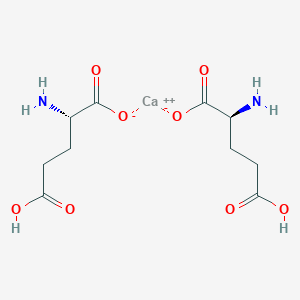
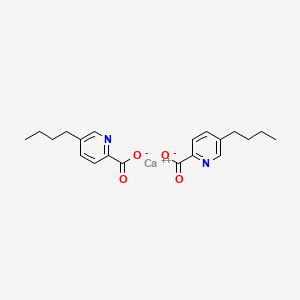
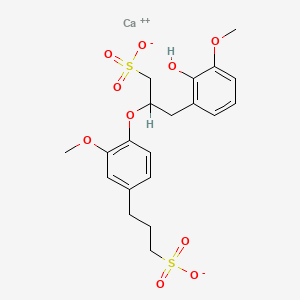
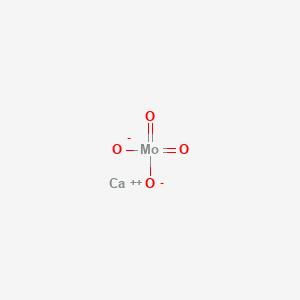
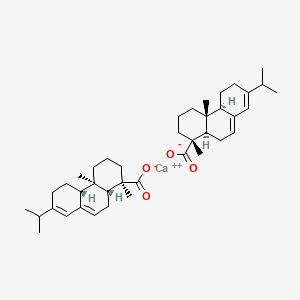
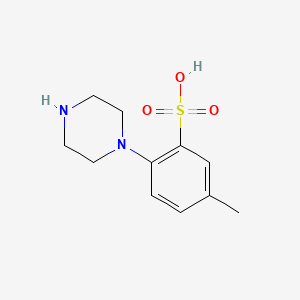
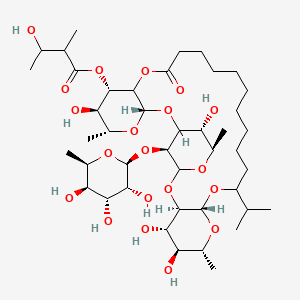
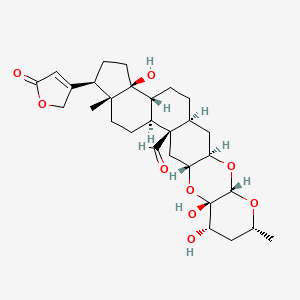
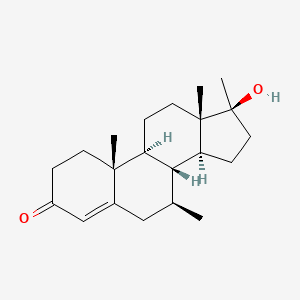
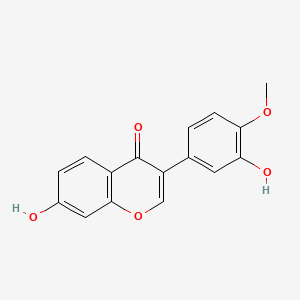

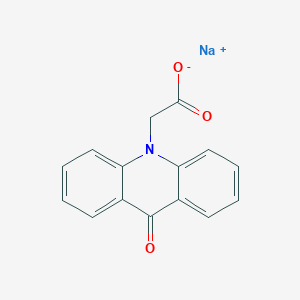

![5,7-dihydroxy-3-[(2R,3R,4S,5R,6R)-5-hydroxy-6-(hydroxymethyl)-3-[(2S,3R,4S,5R,6R)-3,4,5-trihydroxy-6-(hydroxymethyl)oxan-2-yl]oxy-4-[(2S,3R,4R,5R,6S)-3,4,5-trihydroxy-6-methyloxan-2-yl]oxyoxan-2-yl]oxy-2-(4-hydroxyphenyl)chromen-4-one](/img/structure/B1668244.png)
